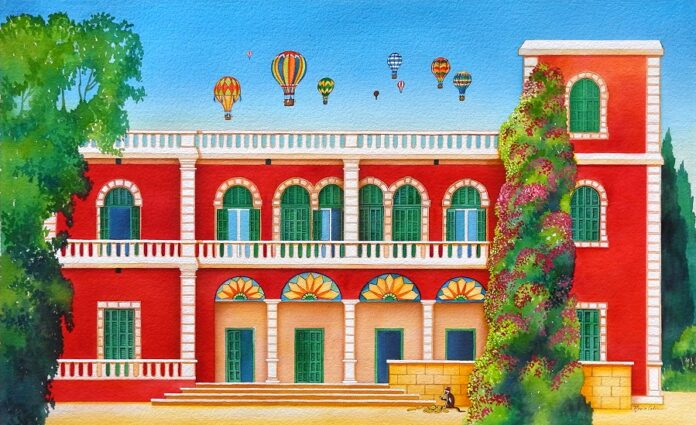DUBAI: Twenty-four years ago, Nayla Audi published her only book: “The Houses of Beirut.” It was created for children — an oversized book in the shape of a house — but at Dubai Design Week last month, adults, too, were opening the ‘doors’ of its cover to reveal the old-school watercolors (created by Audi’s friend, the painter Flavia Codsi) within.
The book’s current revival was made possible by Audi’s two daughters, Yasmine and Julie, who published a new edition in the wake of the Beirut Port explosion last year, having found a copy of the book — a nostalgic memento of their childhood — that had survived the damage inflicted on their family home in the city’s Gemmayze neighborhood.
Nayla, Yasmine and Julie Audi. (Supplied)
“It really affected us personally,” Julie, who lives in London, told Arab News. “We thought we needed to do everything we can to preserve this book — to re-edit and try our best for these houses to stay. We grew up taking all these things for granted. But now, with a bit of maturity and age, we also realize that it’s important for us to continue what our mom started.”
The original version of the book, published in both English and French, was, Julie said, popular among the Lebanese.
“A lot of people in our generation kind of grew up with this book,” she explained. “Through this project, people sent us messages saying: ‘It reminds me of my childhood.’ Or, ‘This was my favorite book growing up.'”
The book’s detailed and idyllic images take the reader through small-but-significant moments of daily life: Students arriving home from school, youngsters running around with the Lebanese flag; a street vendor filling a basket with vegetables, and the serene blue of the sea beside the corniche.
(Supplied)
But, as the name suggests, it is the tall traditional houses with their red-tile roofs and triple arches, which can be seen throughout the streets of the Lebanese capital, that take center stage.
“She realized how important the heritage houses were in Beirut and how important it was for us — we were very little at the time — to have them as a memory,” Yasmine said.
Many of those heritage houses, some of which were built over a century ago, were seriously affected by the explosion and the sisters have stipulated that all proceeds from the sale of the book will be donated to the Beirut Heritage Initiative, launched in 2020 to restore badly damaged historical buildings.
(Supplied)
Apart from the fact that their mother wrote it, “The Houses of Beirut” is intensely personal to the sisters in other ways. Julie and Yasmine (and their cat) actually feature in the charming, colorful pages and they grew up in one of the depicted heritage houses — the ‘White House’ of the book.
“The interior has an open, traditional layout — the living room in the middle and the rooms on the side,” Yasmine said. “When we were growing up, the balcony was our favorite place. It was kind of like our playground.”
For the reprinting of the hand-bound book, the sisters kept the story as it was, (although they printed the English version only) and even turned to the same family-run printing press — Anis, established in the late 1950s — that published it in the first place. Like many businesses in Beirut, Anis was practically destroyed, so getting things off the ground has been a struggle.
(Supplied)
“We kept coming back to the fact that we’re doing this, also, to help Lebanon,” Yasmine said. “So, why would we print the book somewhere else and not help the actual artisans in Lebanon, who have been affected by the economic crisis and everything that’s been happening?”
Both Julie and Yasmine were born in the US, but feel a strong attachment to Lebanon. They flew to Beirut after the explosion and that experience reinforced their belief in the necessity of chronicling the city’s architectural traditions.
“It’s this cycle, which is sometimes a bit sad when you’re from Lebanon, of how every generation has to go through these hardships,” said Julie. “There are so many issues nowadays, but preserving our heritage is really important.”

